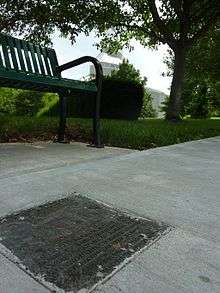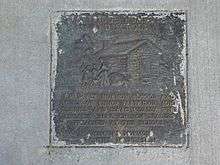Edward Partridge
Edward Partridge Sr. (August 27, 1793 – May 27, 1840) was one of the earliest converts to the Latter Day Saint movement and served as its first Bishop of the Church.
| Edward Partridge | |
|---|---|
 | |
| Bishop of the Church | |
| February 4, 1831 – May 27, 1840 | |
| Called by | Joseph Smith |
| Personal details | |
| Born | August 27, 1793 Pittsfield, Massachusetts, United States |
| Died | May 27, 1840 (aged 46) Nauvoo, Illinois, United States |
| Resting place | Old Nauvoo Burial Grounds 40.5369°N 91.3507°W |
Biography
Edward Partridge was the grandson of Massachusetts Congressman Oliver Partridge, Esq., and a member of a family noted for commercial, social, political, and military leadership in Western Massachusetts.
Partridge owned a hat-making factory and retail store in Painesville, Ohio. He was sent to New York in 1830 by a group of Painesville citizens to investigate the Church of Jesus Christ of Latter-Day Saints. He was baptized a member of the Church of Christ, later renamed The Church of Jesus Christ of Latter-day Saints,[1][2] in or near Seneca Lake, New York, on December 11, 1830, and upon his return to Painesville discovered that his wife had also become a convert.[3]
Church service
Two months later in Kirtland, Ohio, Partridge became the first to hold the prominent position of bishop. In this position he helped lead the Mormon settlement in Jackson County, Missouri, and managed land distribution under the law of consecration. He was tarred and feathered by an anti-Mormon mob in July 1833, then forced to move to Clay County, Missouri, followed by Caldwell County in 1836. During 1835, he served a mission in Illinois, Iowa, Ohio, and Indiana, then entered into another mission in New York and New England. Following the 1838 Mormon War, Partridge was jailed in Richmond, Missouri; in 1839, he was expelled from the state.[4]


Partridge expended much of his wealth in support of the movement before he died in late May 1840 at Nauvoo, Illinois. Joseph Smith suggested that Partridge's death could be attributed to the stress and persecution which he and other Mormon settlers in western Missouri were subjected to in the 1830s.[5]
After Partridge died, his widow Lydia married William Huntington, father of Zina D. H. Young.
Ancestors and descendants
Patridge's ancestors include the early American poets Rev. Edward Taylor and Anne Bradstreet. His forebears also include a number of notable Anglo-American religious leaders including the Rev. John Cotton, Dean of Emmanuel College, Cambridge who was the spiritual leader of the New England colonies; Rev. Solomon Stoddard, one of the most influential colonial ministers and the grandfather of the famous Rev. Jonathan Edwards and ancestor of United States Vice President Aaron Burr (Edward Partridge and Aaron Burr are 3rd cousins)
Partridge's ancestors also include a number of significant early political leaders in Colonial American and early U.S. history, including Connecticut Governor Thomas Welles, Massachusetts Governor John Haynes, Connecticut Governor George Wyllys, Massachusetts Governor Thomas Dudley, and Massachusetts Governor Simon Bradstreet. His daughter Emily Partridge was a plural wife of Joseph Smith, and the future first Territorial Governor of Utah, Brigham Young. His daughter Eliza Maria Partridge also married Joseph Smith, and then Utah Territorial Legislator Amasa M. Lyman, delegate to the California Constitutional Convention and leader of the first organized Anglo-American colony in Southern California. His son Edward Partridge Jr. was a member of the Utah Territorial Legislature and a delegate to the Utah Constitutional Convention.
References
- Manuscript History of the Church, LDS Church Archives, book A-1, p. 37; reproduced in Dean C. Jessee (comp.) (1989). The Papers of Joseph Smith: Autobiographical and Historical Writings (Salt Lake City, Utah: Deseret Book) 1:302–03.
- H. Michael Marquardt and Wesley P. Walters (1994). Inventing Mormonism: Tradition and the Historical Record (Salt Lake City, Utah: Signature Books) p. 160.
- Harper, Steven C. (Summer 2006), "Dictated by Christ", Journal of the Early Republic, University of Pennsylvania Press, 26 (2): 285–286, doi:10.1353/jer.2006.0026, JSTOR 30043410
- Biography Archived 2012-01-04 at the Wayback Machine of Edward Partridge, The Joseph Smith Papers (accessed December 27, 2011)
- Smith, Joseph (December 15, 1855), "May 1840 (reprint)", History of Joseph Smith, Millennial Star, 17, Salt Lake City, Utah: The Church of Jesus Christ of Latter-day Saints, p. 789
Further reading
- Collette, D. Brent (1977), In Search of Zion: A Description of Early Mormon Millennial Utopianism as Revealed Through the Life of Edward Partridge, [Master's Thesis], Provo, Utah: Brigham Young University.
- Farnes, Sherilyn (2009), Fact, Fiction and Family Tradition: The Life of Edward Partridge (1793-1840), The First Bishop of The Church of Jesus Christ of Latter-day Saints, [Master's Thesis], Provo, Utah: Brigham Young University.
- Jenson, Andrew (1901), "Partridge, Edward", Latter-day Saint Biographical Encyclopedia, 1, Salt Lake City: Andrew Jenson History Company, pp. 218–22, 488.
- Jessee, Dean C. (June 1979), "'Steadfastness and Patient Endurance': The Legacy of Edward Partridge", Ensign, 9 (6): 40–47.
- Partridge, Edward (Summer 1978), Warren A. Jennings (ed.), "'What Crime Have I Been Guilty of?': Edward Partridge's Letter to an Estranged Sister", BYU Studies, 18 (4): 520–28.
- Partridge, Scott H. (2003), "Edward Partridge in Painesville, Ohio", BYU Studies, 42 (1): 51–73.
- Quinn, D. Michael (December 1973), "Did the Lord Call Bishop Partridge to be a Presiding Bishop?", Ensign, 3 (12): 32.
- Smith, Heman Hale (October 1908), "Edward Partridge", Journal of History, 1 (4): 413–22.
- Whitney, Orson F. (July 1916), "Edward Partridge", The Utah Genealogical and Historical Magazine, 7 (3): 105–9.
- Winder, Michael K. (2003), "Edward Partridge", Presiding Bishops, Salt Lake City: Eborn Books, pp. 11–23, ISBN 1-890718-10-6.
- Wixom, Hartt (1998), Edward Partridge: The First Bishop of the Church of Jesus Christ of Latter-day Saints, Springville, Utah: Cedar Fort, Inc., ISBN 978-1-55517-362-3, OCLC 5066439.
External resources

- Grampa Bill's G.A. Pages, archived from the original on 2011-06-05
| Church of Jesus Christ of Latter Day Saints titles | ||
|---|---|---|
| New title | Bishop of the Church February 4, 1831 – May 27, 1840 |
Position Vacant May 27, 1840 – October 7, 1844 Succeeded by: Newel K. Whitney as Bishop of the Church of The Church of Jesus Christ of Latter-day Saints |